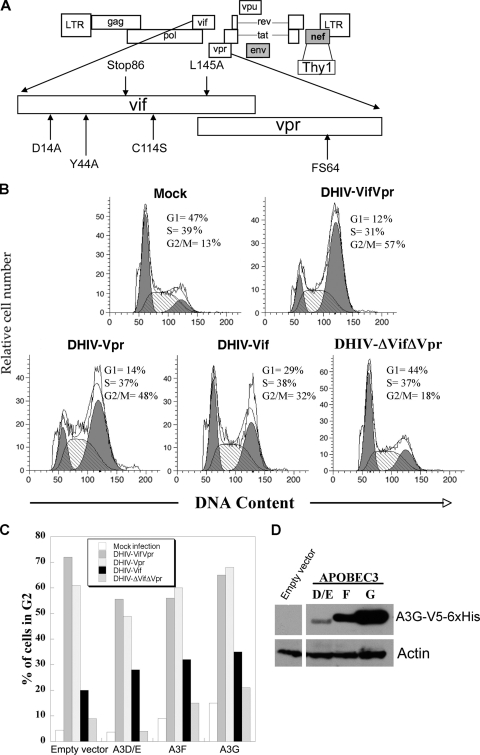FIG. 1.
Vif and Vpr induce cell cycle accumulation in G2 in an additive manner. (A) Schematic diagram of an envelope-defective vector system. The nef open reading frame was replaced by that of the murine Thy1 (muThy1) glycoprotein. Production of infectious virus was achieved by cotransfection with an expression vector for the vesicular stomatitis virus glycoprotein G. Point mutations in Vif and Vpr used in this study are shown. DHIV-VifVpr encodes wt Vif and Vpr. DHIV-Vif encodes wt Vif and a truncated, nonfunctional Vpr (FS64). DHIV-Vpr encodes wt Vpr and truncated, nonfunctional Vif (STOP86). (B) SupT1-transformed lymphocytes were infected with various defective vectors as indicated, and at 48 h postinfection, the cell cycle profile of infected cells was stained for muThy1.2 and DNA content; electronic gating for muThy1.2-positive cells allowed for analysis of infected cells. DHIV-ΔVifΔVpr encodes both nonfunctional Vif and Vpr. (C) HEK293T cells were transfected by calcium phosphate precipitation with empty vector or with an expression vector for the indicated APOBEC3 variants fused to an amino-terminal V5 epitope tag. At 24 h posttransfection, cells were infected with the indicated viral vectors. At 48 h post infection, cells were stained for DNA content and analyzed as described in the legend to panel B. Transfection efficiencies, as estimated by green fluorescent protein from an internal control construct in each transfection, were equal to or greater than 90%. (D) APOBEC3 expression from cells shown in panel C was verified by Western blotting using an antibody to the V5 tag.

